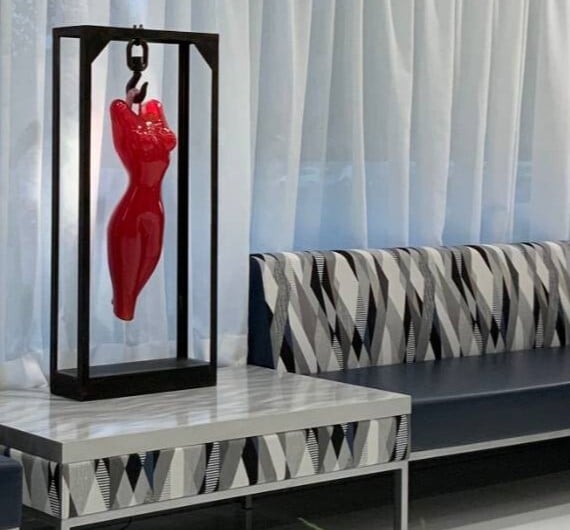Introduction
In the two previous section, How Do Silicone Gels Differ?, I discussed how silicone gels used in breast implants differ in their properties, and how the individual characteristics of these gels impact the behaviour of the implant, as well as the resultant look and feel of the augmented breast.
In this section, I will address some other important characteristics of breast implants – shape, surface texture and profile. All of these parameters come into play when selecting an implant for a particular patient. While I do not expect the patient to be able to independently and accurately select the best implant for their breasts (that is my role), I do think it is important for the patient to have a fundamental understanding of these principles so that they can participate in the decision making process.
I will address the older, generation V breast implants (Allergan, Mentor and Sientra) as well as the new generation VI Motiva implants.
Shape: What is the difference between round and teardrop (anatomical) implants?
Implants come in basically two shapes, round and anatomical. The anatomical implants are also known as teardrop implants. Currently, both saline implants as well as silicone gel implants are available in round (Allergan Natrelle, Mentor, Sientra) and anatomical shapes (Sientra). When I state anatomical (teardrop), I am referring to an implant that has a teardrop shape in any position that you look at it. In other words, the teardrop shape is fixed. It does not change when the implant is lying flat or standing upright.
When choosing breast implants, shape is an important consideration. The two basic breast implant shapes are round and teardrop. Breasts differ greatly from woman to woman, so the ideal breast implant shape for each patient must be determined with care. Let’s discuss the difference in shape, round versus teardrop first. Next I will address profile and surface (smooth versus textured).
Round Breast Implants. Of the two breast implant shapes, the round breast implant is the most common type used by most plastic surgeons for breast augmentation. Round implants are easier for the surgeon to work with. If a round implant is turned, it is still round. Many women choose round implants because they believe that round implants tend to provide the greatest amount of lift, fullness, and cleavage. This is in fact, not entirely true. If you have a breast that is small, with a tight skin envelope such as a young woman who never had children, then any implant, round or teardrop, will tend to give a very full, high, unnatural look especially if the implant is too large for that breast. It has absolutely nothing to do with the shape of the implant itself. If a saline implant is used and it is overfilled, then the same result will occur. All of these situations have nothing to do with the implant shape – it has to do with filling the breast pocket with too large an implant, or overfilling the implant itself, both situations of which will cause distortion and produce an unnatural breast with a very high, rounded look on top.
Some women, however, feel that the results produced with round implants appear artificial, so they seek out more natural-looking alternatives (anatomical or “teardrop” implant)*. Some women may prefer the “artificial look” and want to look like they have implants – this is the minority of my patients. Due to a round implant’s symmetrical shape, the shape of the breast is not compromised should the implant rotate. If the implant should rotate, and I expect that all smooth round implants do rotate, the shape is still exactly the same, round.
Teardrop ("Anatomical") Breast Implants. As the name indicates, a teardrop breast implant, also known as a contoured or anatomical breast implant, is shaped like a teardrop. Breasts attain a more gently sloping contour with teardrop breast implants. Teardrop implants better resemble the natural shape of the breast. There is greater preservation of the contour and fullness of the upper portion of the breast, and less overstretching, also known as “bottoming-out”. They require much more care in placement. When inserted, they are often tilted to better follow the natural contour of the breast. The degree of tilt requires more attention if the degree of symmetry is to be optimized. The teardrop-shaped implants often provide greater projection by volume. For women who want more naturally shaped teardrop breasts, these implants may be the ideal choice. Breasts with teardrop shaped implants typically excel in appearance in women who have loss of fullness and stretching secondary to pregnancy and lactation. Note: one of the problems with conventional teardrop implants is rotation of the implant within the breast pocket resulting in change in breast shape.
The Allergan Natrelle anatomical "teardrop" implant was previously available in both saline and silicone gel. The important thing to know about these devices is that the teardrop shape is fixed. The implant does not adjust its shape with position in the body. The implant must be placed into the breast precisely as you want the teardrop shape to appear. If the implant rotates within the breast, the breast shape will change, and it will not be for the better! On the other hand, if a round implant rotates, the shape of the breast remains constant. You will not even be aware of the implant rotating, if it should do so. So how do we prevent a teardrop implant from rotating inside the breast?
The macro-textured surface (a rough surface you can see and feel) anchors the implant to the surrounding tissues (like Velcro) and prevents movement of the implant within the breast implant pocket. Again, without such adherence, the teardrop implant would rotate within the pocket, making your breast continually change shape – not a very desirable thing! The reality is that one of the problems with a teardrop shaped implant is that they often break free of their attachment to the chest wall and underside of the breast and rotate. I have placed several hundred pairs of these implants and I have received many phone calls from women complaining that they woke up in the morning and their breasts have taken on a disturbing shape. I would then have to walk them trough the process of how to de-rotate their implant. These calls usually were made on a saturday morning - you do the math!!! So at this point, you have many women who prefer the look of a teardrop implant, but it is now no longer available (keep reading - this changes!).
With the recent July 2019 recall of textured surface breast implants (both saline and silicone gel filled) due to concerns regarding ALCL, the only silicone gel filled implants available from Allergan Natrelle are round, smooth implants. The recall had to do with the macro textured surface, not the saline or silicone inside the implant. What about teardrop shaped smooth implants? If the teardrop shape is fixed, like all the teardrop implants from Allergan, Mentor and Sientra, then the smooth surface would render the implant able to rotate freely inside the breast, which would result in the breast continually changing its shape, and not for the best!
So we know that a smooth implant with a fixed shape would rotate inside the breast and therefore would not be a good idea, but what if there was a smooth round implant that could change into a teardrop shape under the influence of gravity, and always maintain its shape with respect to gravity? Hmmmm....... now that's an interesting idea!
Motiva® Round and Ergonomix Breast Implants
Now we have a totally new option. Motiva implants come in both Round and Ergonomix (teardrop) shapes. But what exactly is the difference? Teardrop is teardrop, right? Wrong!
If you look at a Motiva implant lying flat on a table, you cannot tell the round from the Ergonomix (teardrop) shape, because they both assume a round shape. The real magic comes when the implant is upright. The round implant will maintain a round shape, with the point of maximal projection at the center of the implant. The Ergonomix implant is different. When standing vertical, the point of maximal projection is below the center of the implant, resulting in the implant assuming an anatomical, or teardrop shape. The unique thing about the Ergonomix implant is that as the implant rotates normally within the breast implant pocket, the gel redistributes itself so that the implant always maintains the same teardrop shape. There is no need for the implant to adhere to the underlying chest wall and overlying breast tissue as all the other older teardrop shaped implants need to do. This also means that the macrotextured surface required of the older teardrop implants is also no longer required. This is but one reason why the Ergonomix implant is a safer option than traditional teardrop shaped implants - it produces the same teardrop shape without any of the risk for developing ALCL, which has never been reported in the over four million Motiva implants currently implanted!
The below animation depicts the shape of the Motiva Round and Ergonomix implants when flat and when upright. You can see that the Motiva Round implant maintains its round shape when upright, with the point of maximal projection of the implant in the center of the implant. In contrast, when upright, the Motiva Ergonomix implant has its point of maximal projection somewhat lower down on the implant, affording a naturally appearing, teardrop shape.
The Ergonomix is on the left, the Round is on the right.
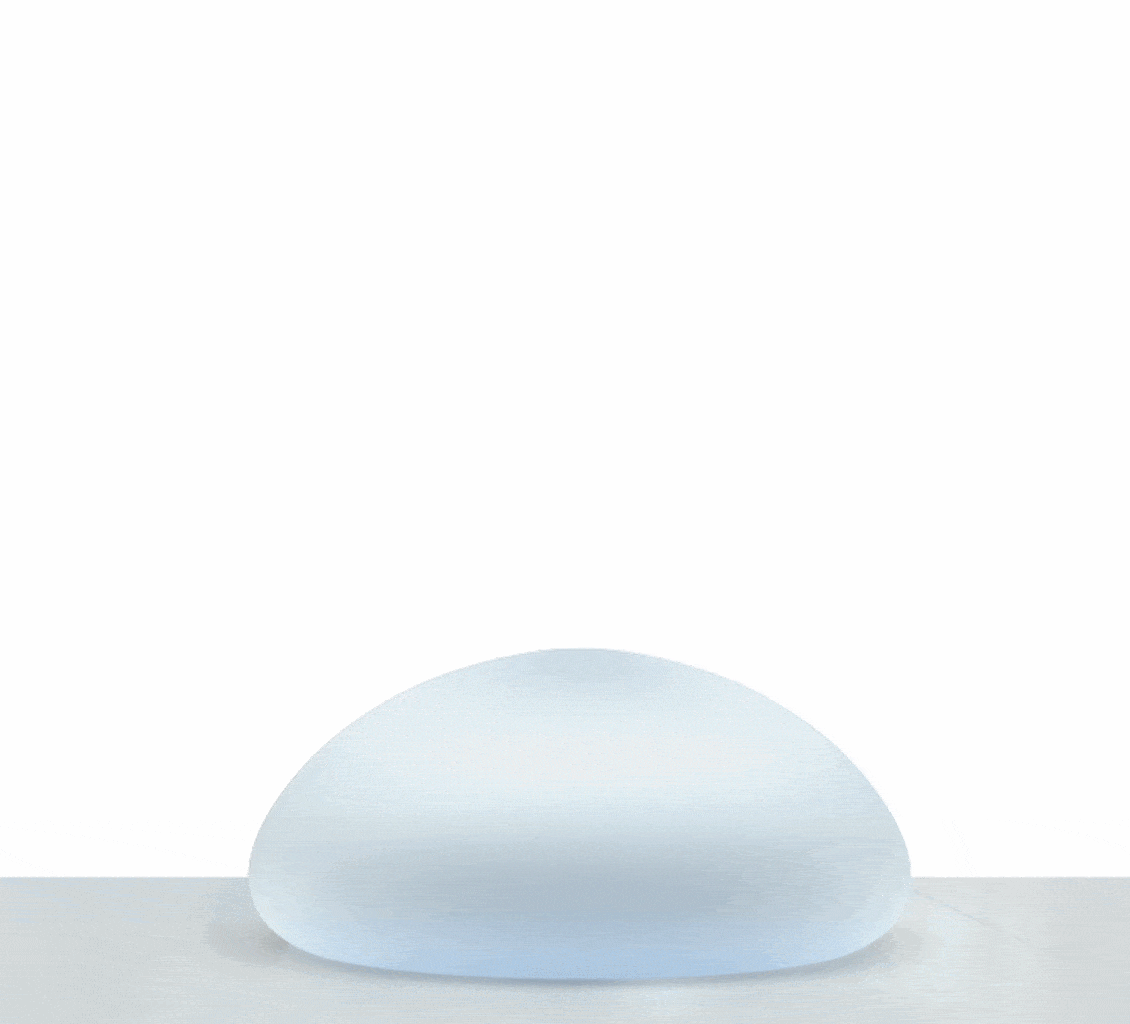

Which implant gives the breast a better shape, round or teardrop?
This is the million dollar question. Beauty is in the eye of the beholder, so a "better" shape is the opinion of the patient. The overall shape of the implant once it is implanted into the breast and is in a vertical position (patient standing upright) will determine its influence on the shape of the breast. If you placed a teardrop shaped solid block of silicone into the breast, it is my belief that in most cases, the breast will look more natural than if one placed a round solid block of silicone. However, we do not use solid blocks of silicone as breast implants – they are unacceptably too firm. That is why breast implants are filled with silicone gel. And it is the behavior of the specific silicone gel AND the surrounding implant shell that will determine the shape of the implant once it is within the breast. The more form stable the implant is, the more it will maintain fullness at the upper portion of the breast. With older implants, this comes at a price – the implant (and the breast) will be firmer. These implants also are subject to collapse of the upper portion of the breast if the gel is not adequately form stable. With the Motiva Ergonomix implant, a teardrop shaped implant can be obtained with stability of shape and softness of feel!
The other key factor is the interaction between implant and breast. If the breast has a tight soft tissue envelope, such as in a young woman who has never been pregnant and has small breasts, the implant will tend to be compressed more and have more upper fullness than when that same implant is placed into a lax breast where there is minimal compression of the implant. In this latter case, the form stability of that implant will contribute more significantly to upper breast fullness than perhaps when that same implant when placed inside a tight breast.
So why do so many people believe round implants produce more upper breast fullness? The reason that some women think that a round implant gives you more upper pole breast fullness is threefold: a round implant larger than desirable for that person’s tissue may have been selected and that person was over augmented, the implant (saline) was overfilled at surgery making it tense which will retain upper pole fullness at the expense of implant shape as the contours of the beast become distorted and lastly the person’s tissue envelope may have been tight to begin with, which will result in more upper pole fullness than a lax tissue envelope (see the previous discussion about type I vs. type II breast types). You can achieve this unnatural, high look with either a round or teardrop implant, so the shape does not matter here. With Motiva implants, the greater form stability will allow the surgeon to better control the shape of the breast by selecting either a round or Ergonomix (teardrop) implant.
It is my opinion, based upon a critical review of my own cases, that in the case of both SALINE and SILICONE implants, that teardrop shaped implants give a more natural shape than round implants in the vast majority of cases. If one looks critically at the breast augmentation cases in my photo gallery, I believe that they will come to the same conclusion. It is important to note that in some women, particularly those with an adequate amount of good quality breast tissue to drape over the implant, that the shape of the implant may be less important to the overall aesthetic result. When making these comparisons, it is important to compare round and teardrop implants with the same degree of form stability, otherwise the comparison is not fair. However, there is no right or wrong answer here: it is totally up to the woman to decide what look she prefers. It is comforting to know that with the Motiva Round and Ergonomix implants, I can offer both round and teardrop shapes with the utmost safety!
Profile: What is the Difference Between Low, Medium and High Profile? Which is Best?
Round silicone gel filled implants come in varied “profiles.” For a given volume of implant, a low profile has a wider base width but less forward projection, a high profile has a narrower base width but a greater forward projection, and a medium profile lies in between the two. Restated another way, “the higher the profile, the narrower the base width and greater the forward projection for a given implant “volume”.
A higher profile can enhance the forward projection of the breast, which would otherwise require a larger volume breast implant with a greater base width that might not fit into the breast. However, such devices are associated with greater thinning of the breast tissue, chest wall deformities and creation of uncorrectable deformities. Conversely, a low profile implant allows you to maximize overall breast volume when you desire or require a lower breast projection. This might seem a bit confusing but the first thing to understand is that the breast is not able to stretch without limitation. There is only so much available width to the breast and only so much distance that the breast can expand forward. As the surgeon, you need to align the patient's desires (as best as possible) with the dimensions of the breast and its individual, unique elastic characteristics to ensure an implant that fits properly in the breast, does not overstretch or damage the breast and achieves the desired appearance.
I find that the medium profile implants seem to give the most consistent, natural results in the majority of women, and the low profile implants work well in women with little breast tissue and very tight soft tissue envelopes. For a breast that is a bit looser, such as in a revision case where an implant has already been placed, especially if the previous implant was already a high profile implant, I am more willing to consider a high profile implant.
Many women tell me during consultation that they want a high profile implant. When I ask why they have this preference, the usual answer is that they want more upper breast fullness. What they are not realizing is that a high profile implant has the smallest base width diameter, and therefore, when lying against the chest wall oriented vertically, there will be the least amount of upper breast fullness with this choice for profile. As surgeon, it is very important to take the time to understand what the patient desires. Most of the time the patient and I are aligned in our preferences, but sometimes not and a discussion needs to be had regarding what is advisable and achievable.
When selecting an implant profile, one must take into account the soft tissue envelope. This is the skin, muscle (when placing the implant below the muscle), the glandular tissue and fatty tissue that will surround the implant. Trying to achieve more forward projection with a high profile implant in a tight tissue envelope will not work because a tight envelope will simply limit the amount of forward projection that you can have and will furthermore probably result in atrophy of breast tissue, overstretching of the breast soft tissue envelope and possibly even a chest wall deformity (depression in contour). An important point to remember is that probably all breast implants will result in some atrophy of the breast tissue, so it is paramount to choose an implant size and profile to minimize this deleterious effect upon the breast tissue. The solution is to go with a lower profile implant. My personal opinion and recommendation, for the vast majority of cases, use either low or medium profile to avoid damage to the breast tissue in terms of atrophy.
Natrelle is Allergan’s brand of silicone gel filled implants. The top row is the Natrelle name for the profile shape, the bottom is my assessment of the profile, probably the easiest way to remember them.

“Moderate Profile”
Low Profile

“Moderate + Profile”
Medium Profile

“High Profile”
High Profile

“Extra High Profile”
Very High Profile
Motiva is Establishment Labs’s brand of silicone gel filled implants. The top row is the Motiva name for the profile shape, the bottom is my assessment of the profile, probably the easiest way to remember them.

“Mini Profile”
Low Profile

“Demi Profile”
Medium Profile

“Full Profile”
High Profile

“Coarse Profile”
Very High Profile
How do Motiva implant profiles compare to Natrelle implant profiles? If you compare the dimensions of the actual implants, you will find that the
Surface: Smooth vs. Textured
First a little more breast implant history: For many years, all breast implants had a silicone shell which possessed either a smooth surface or a “rough” or textured (aka "macrotextured") surface. The textured surface was developed many years ago in an attempt to reduce the rate of capsule contracture. Whether or not this has worked is somewhat debatable. Some believed that when the implant was placed under the muscle, the textured surface seems to reduce the rate of capsule contracture, but not so when placed above the muscle. There are other factors that also affect the rate of capsule contracture including the person's own biologic propensity to make thicker capsules, infection, implant contamination during surgery and others.
An implant with a smooth surface can freely move and turn within the breast pocket, but an implant with a textured surface “sticks” to the surrounding tissue in a fashion similar to Velcro. The greater the "texturing", the greater this effect. A textured surface looks and feels "rough", and this "roughness" will vary depending upon the degree of texturing desired. A textured surface will keep the implant anchored in position so that it cannot rotate.
When using a traditional teardrop shaped implant, loss of adherence to the chest wall will result in an undesireable rotation of the implant producing an unpleasant alteration in breast shape. This is because the traditional teardrop implant shape is fixed, and does not "re-adjust" due to gravity. As stated previously, Motiva Ergonomix implants do not have this issue because they are actually a round implant that re-shapes to a teardrop shape when upright under the influence of gravity. This will be discussed further on.
The two different surfaces give the surgeon some additional choices in optimizing the breast augmentation results. In the case of a patient with better quality breast tissue, with good thickness, a textured implant will attach to the chest wall and the underside of the breast tissue or muscle, and may result in less stress on the lower portion of the breast because all the weight of the implant isn’t sitting on the bottom of the breast. This is somewhat theoretical. In the case of a patient with very thin tissue, a textured surface will attach to the underside of that tissue, and may be more likely to demonstrate visible rippling as when the implant ripples; it pulls the breast tissue in with it, causing a visible ripple in the breast surface.
In the case of traditional teardrop implants, there really is no choice in surface texture. One needs attachment to the surrounding tissues, or else the implant will rotate within the pocket and the breast shape will constantly change as the implant rotates. This is not an issue with round implants because if they rotate, the shape remains the same. The advantage in choosing a teardrop implant, be it saline or silicone, is a more natural shape and, in especially the case of the silicone teardrop implant which is firmer and thus more "form stable" (can hold its shape better), with better preservation of that shape over time as compared to a round implant.
Shown below are a comparison of four augmentations performed using Natrelle round smooth saline, anatomic textured saline, round smooth silicone gel implants and anatomic textured silicone gel implants all placed under the muscle. In the case of the silicone gel implants, it is in my opinion that there is a difference between the round and the traditional teardrop (anatomical) implants. There is no "better" choice, it is all personal preference.
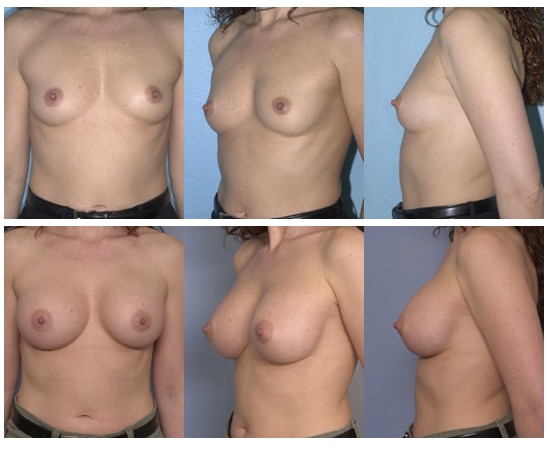
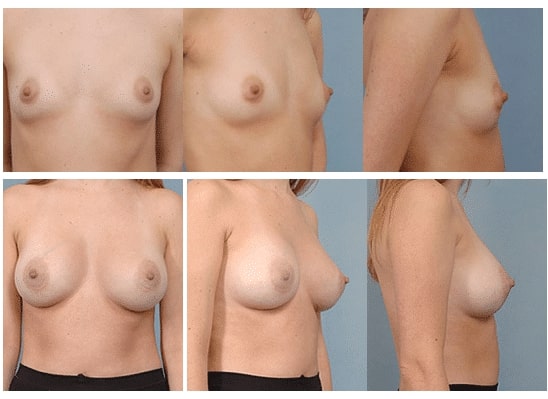
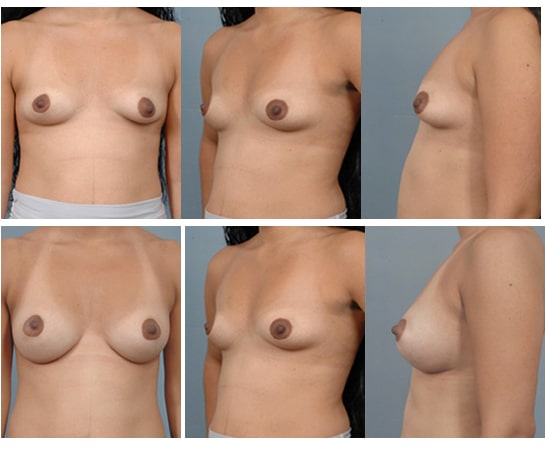
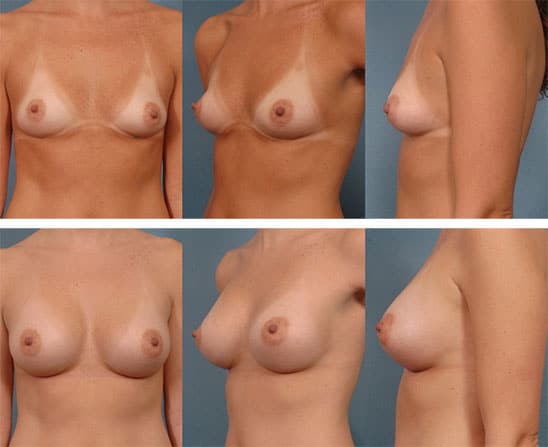
Traditional Teardrop (Anatomical) Implants are No Longer Available! What Happened??
In the case of silicone implants, I think that the coherent nature of silicone gel affords silicone gel filled implants an advantage over saline filled implants. Remember, the outer shell of both implants is silicone. Silicone gel implants are softer and have a more natural feel than saline implants, so the breast tends to retain its natural shape tendency, rather than have it influenced by the firmness of a saline implant.
Initially, the only traditional teardrop I had available was the Allergan Natrelle 468 which was filled with saline. In February, 2013, the Allergan Natrelle 410 anatomical silicone gel implants received FDA approval. These implants have been in use in other countries for about 15 years prior to their obtaining FDA approval in the United States. The main advantage of these devices is the superior preservation of the shape of the breast over time as compared with all the other types of implants. My own experience with hundreds of these implants supports this.
However, in July 2019, due to concerns about an association between textured surface implants and the development of Anaplastic Large Cell Lymphoma (ALCL), a rare malignancy involving not the breast tissue itself but the scar tissue capsule that forms around all breast implants, Allergan voluntarily removed their textured devices from the market. I personally would not recommend at this time using this or any other macrotextured implant. The risk of developing ALCL, although quite small, is simply not worth taking for what might be a very modest improvement in breast contour. This not withstanding the 1-2% risk of teardrop implant rotation causing annoying changes in breast shape. From July 2019 until September 2024, I only recommended using round smooth silicone gel filled implants. For me, that was the Allergan Natrelle Responsive, Soft-Touch and Cohesive implants.
Motiva - Is it Smooth, Textured or What?
This is an interesting topic. First, there is no such thing as a perfectly smooth surface.
There is actually a classifcation scheme for texturing of surfaces in breast implants. The 2018 ISO (International Organization for Standardization) classified as follows:
- Smooth: < 10 Microns of roughness:
- Microtextured: 10 - 50 Microns of roughness
- Macrotextured: > 50 Microns of roughness
Several common breast implants from various manufacturers are shown in the chart below (credit: Munhoz, A., et al: Plast Reconstru Surg Glob Open 2019 Oct 15;7(10):e2466):
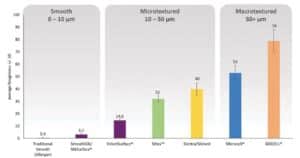
- Smooth category: are the traditional smooth implants (0.3 microns - which as previously stated are really not smooth) and the Establishment Labs Motiva SilkSurface/SmoothSIlk surface technology (3.2 microns). SilkSurface and SmoothSIlk are really two different terms used interchangeably to refer to the same surface technology.
- Microtextured category: Establishment Labs VelvetSmooth (14.6 microns), Mentor Siltex (32 microns) and Sientra's (40 microns) surface technology.
- Macrotextured category: Allergan Natrelle Microcell (53 microns) and Biocell (79 microns).
You can see that the Allergan Natrelle Teardrop implant (Biocell surface) has the most texturing. It did probably the best job of holding the implant in place, but also had the highest rate of ALCL. The theory behind this was probably that certain species of bacteria could hide from the bodies immune defenses more easily in the nooks and crannies (like an english muffin) of an implant surface with more roughness.
The ISO classification scheme was changed in 2024. The current scheme does not make a lot of sense, nor does it seem to follow what is already known in the published scientific literature. That said, for the purposes of discussion, we will assume that smooth surface implants are in fact smooth. Classification schemes are all semantics and it is important to not get led down a "rabbit-hole" by this. It is best to look at the individual mechanical and biological characteristics of a device rather than a "classification scheme" which can be very misleading.
Currently, Motiva devices are classified by the FDA and are labeled as such as a "SilkSurface" device. The word "texturing" does not appear anywhere on the package labelling. If you want to get technical, you could call Motiva SilkSurface a 3 micron textured surface, but if you do, then you should call a smooth surface a 0.3 micron textured surface. The bottom line is, you cannot consider a Motiva implant surface to be anything like a macrotextured surface like the Allergan Natrelle Biocell surface that was recalled for its relationship to ALCL. Similarly, you cannot consider the Motiva SIlkSurface to be anything like the Mentor and Sientra microtextured surfaces.
What matters is how the surface interacts with the bodies tissues and what biological and mechanical characteristics it will have, not what label it was given in some classification scheme. More is available to learn on this subject here.
Topics - What Implant Type Do I Need
Sections – Five Key Decisions You Need To Make
Chapters – Breast Augmentation Guide
- Intro to Breast Augmentation
- Motiva Breast Implants
- Five key decisions you need to make
- One-Day Recovery Breast Augmentation
- Anesthesia – General, Sedation or Local?
- Breast Lift (Mastopexy) with/without Implants or Fat
- What else should I know about breast augmentation?
- Important Things to Consider When You Decide to Move Forward With Breast Augmentation
- Revision of breast augmentation
- ALCL and Breast Implant Illness


